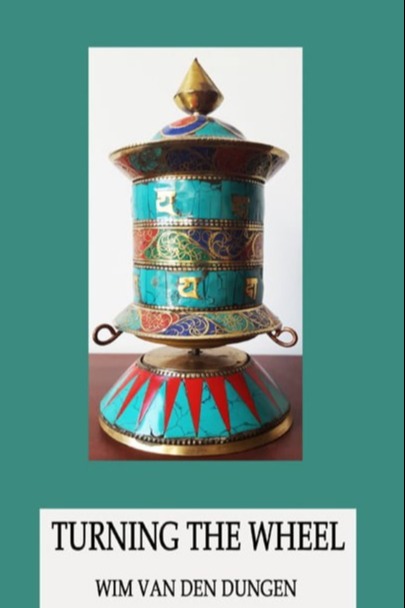
Turning the Wheel
The Buddha of Compassion, the Maṇi Mantra and Wheel

The Buddha of Compassion, the Maṇi Mantra and Wheel
The Lotus Wheels found at the entrance of Tibetan monasteries and institutes anchored in the earth and spun by hand are 'Ground Wheels' or 'Earth Wheels.' Tradition claims that sentient beings dwelling in that place and turning them accumulate merits quickly and attain enlightenment faster, if not immediately. When turned by the heat of the fire, it is called a 'Fire Wheel.' If turned by the wind, an 'Air Wheel' and if by water, a 'Water Wheel.' It is said that wherever the smoke of the fire of a Fire Wheel pervades, Buddhahood is attained (quickly). The same goes for blessed wind and water. With the advent of electricity, solar energy may also turn the wheel. These practices point to shamanism, tantrism and its hylic pluralism.
Here, a fifth wheel type, the so-called 'Hand Wheel' is investigated. Held in the right hand and turned by a small movement of the wrist, whoever sees, hears, recalls, or touches that person turning (the wheel) attains Buddhahood without taking a long time. Tantric undertones are heard.
The Kāraṇḍavyūha Sūtra is a Mahāyāna text integrating the tantras of Avalokiteśvara. This sūtra indicates religious syncretism, where various religious traditions and teachings are harmoniously combined. It suggests that the practice of the maṇi-mantra was available to a wide audience.
Avalokiteśvara's compassionate activity is profound and active. His is not a mere wish to alleviate suffering but an active endeavor to end it. His compassion is not limited to those with 'good karma.' It extends to all, irrespective of their past deeds.
As the Buddha of Compassion, he solely aims to halt the cycle of birth, death, and rebirth.
Avalokiteśvara's maṇi mantra, Oṃ Maṇi Padme Hūṃ, consists of six-syllables with profound salvic associations. The practice of the maṇi-mantra became accessible to all Buddhists, especially laypeople. Even the visualizations and other tantric practices associated with it were not restricted to those who had received specific initiations, usually monks and nuns.
The act of reciting the mantra itself became a form of initiation.
This inclusive approach to compassion underscores the core of Mahāyāna Buddhism : to attain for the benefit of all sentient beings. The maṇi wheel represents the maṇi mantra in physical form.
Besides historical introductions, the actual contents of a consecrated wheel are discussed.
An alternative view of the practice is attempted.

Turning the Wheel
POD BOOK
© 2021 by Wim van den Dungen
328 pages
available in the LULU Bookstore
ISBN : 978-0-359-36379-7

Turning the Wheel
PDF EBOOK
© 2021 by Wim van den Dungen
6.03 MB
available in the LULU Bookstore
revised